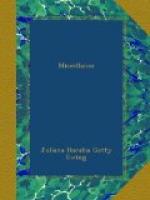Larch-wood is light, strong, and durable. It is used for beams and for ship-building, for railroad-sleepers and mill-axles, for water-pipes, and for panels for pictures. Evelyn says that Raphael, the great painter, painted many of his pictures on larch-wood. It will stand in heat and wet, under water and above ground. It yields good turpentine, but trees that have been tapped to procure this are of no use afterwards for building purposes. The larch is said not to make good masts for ships, but its durability in all varieties of temperature and changes of weather make it valuable for vine-props. When made of larch-poles these are never taken up as hop-poles are. Year after year the vines climb them and fade at their feet, and they are said to have outlasted at least one generation of vine-growers.
In “little woods” the larches are planted very close, so that they may “spindle up” and become tall before they grow thick. They are then used for hop-poles and props of various kinds.
The Oak (Quercus robur, &c.) is pre-eminently a British tree. Of its beauty, size, the venerable age it will attain, and its historical associations, we have no space to speak here, and our young readers are probably not ignorant on the subject.
The durability of its wood is proverbial. The bark is also of great value, and though the slow growth of the oak in its earlier years postpones profit to the planter, it does so little harm to other wood grown with it (being in this respect very different from the beech), that profitable coppice-wood and other trees may be grown in the same plantation.
The age at which the oak should be felled for ship-timber, &c., depends on many circumstances, and is fixed by different authorities at from eighty to a hundred and fifty years.
Oaks are said to be more liable than other trees to be struck by lightning.
Oak-coppices or “little woods” are cut over at from twelve to thirty years old. The bark is valuable as well as the wood.
The Pine (Pinus sylvestris, &c.), like the larch, will flourish on poor soils. It is valuable as a protection for other trees. The varieties and variations of this tree are very numerous.




